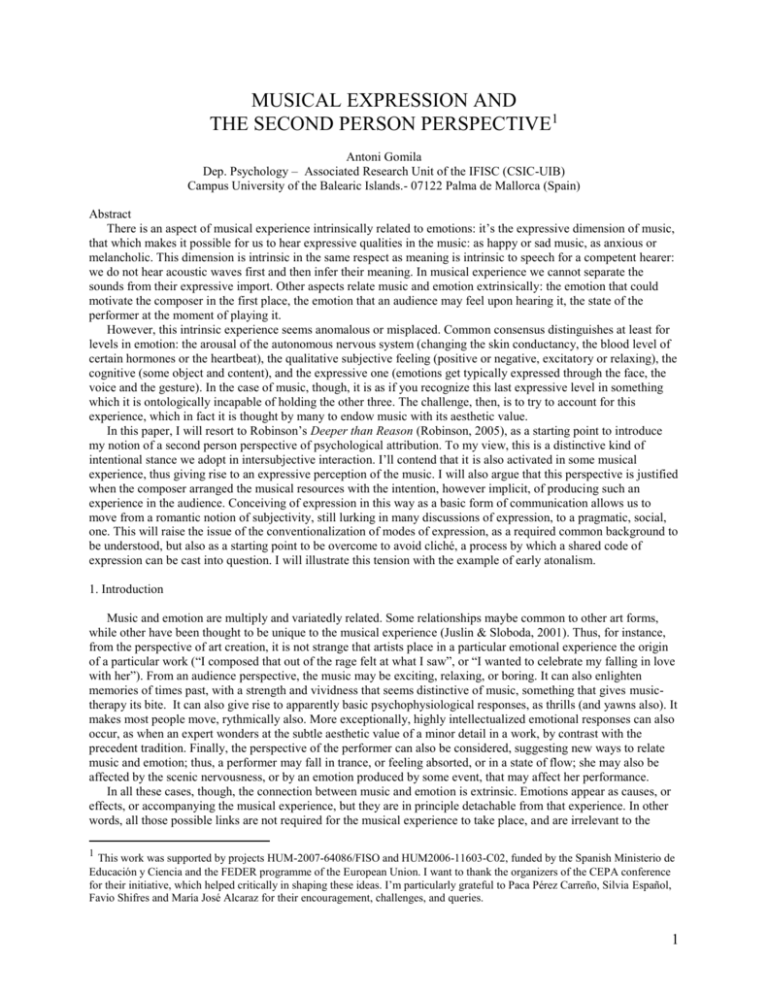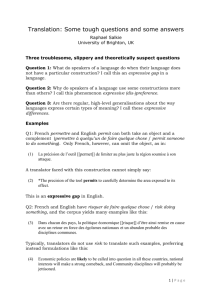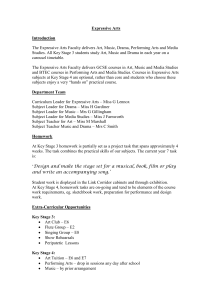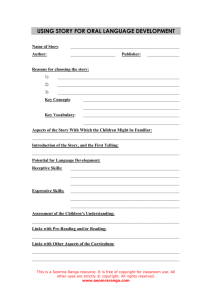musical expression and the second person perspective
advertisement

MUSICAL EXPRESSION AND THE SECOND PERSON PERSPECTIVE1 Antoni Gomila Dep. Psychology – Associated Research Unit of the IFISC (CSIC-UIB) Campus University of the Balearic Islands.- 07122 Palma de Mallorca (Spain) Abstract There is an aspect of musical experience intrinsically related to emotions: it’s the expressive dimension of music, that which makes it possible for us to hear expressive qualities in the music: as happy or sad music, as anxious or melancholic. This dimension is intrinsic in the same respect as meaning is intrinsic to speech for a competent hearer: we do not hear acoustic waves first and then infer their meaning. In musical experience we cannot separate the sounds from their expressive import. Other aspects relate music and emotion extrinsically: the emotion that could motivate the composer in the first place, the emotion that an audience may feel upon hearing it, the state of the performer at the moment of playing it. However, this intrinsic experience seems anomalous or misplaced. Common consensus distinguishes at least for levels in emotion: the arousal of the autonomous nervous system (changing the skin conductancy, the blood level of certain hormones or the heartbeat), the qualitative subjective feeling (positive or negative, excitatory or relaxing), the cognitive (some object and content), and the expressive one (emotions get typically expressed through the face, the voice and the gesture). In the case of music, though, it is as if you recognize this last expressive level in something which it is ontologically incapable of holding the other three. The challenge, then, is to try to account for this experience, which in fact it is thought by many to endow music with its aesthetic value. In this paper, I will resort to Robinson’s Deeper than Reason (Robinson, 2005), as a starting point to introduce my notion of a second person perspective of psychological attribution. To my view, this is a distinctive kind of intentional stance we adopt in intersubjective interaction. I’ll contend that it is also activated in some musical experience, thus giving rise to an expressive perception of the music. I will also argue that this perspective is justified when the composer arranged the musical resources with the intention, however implicit, of producing such an experience in the audience. Conceiving of expression in this way as a basic form of communication allows us to move from a romantic notion of subjectivity, still lurking in many discussions of expression, to a pragmatic, social, one. This will raise the issue of the conventionalization of modes of expression, as a required common background to be understood, but also as a starting point to be overcome to avoid cliché, a process by which a shared code of expression can be cast into question. I will illustrate this tension with the example of early atonalism. 1. Introduction Music and emotion are multiply and variatedly related. Some relationships maybe common to other art forms, while other have been thought to be unique to the musical experience (Juslin & Sloboda, 2001). Thus, for instance, from the perspective of art creation, it is not strange that artists place in a particular emotional experience the origin of a particular work (“I composed that out of the rage felt at what I saw”, or “I wanted to celebrate my falling in love with her”). From an audience perspective, the music may be exciting, relaxing, or boring. It can also enlighten memories of times past, with a strength and vividness that seems distinctive of music, something that gives musictherapy its bite. It can also give rise to apparently basic psychophysiological responses, as thrills (and yawns also). It makes most people move, rythmically also. More exceptionally, highly intellectualized emotional responses can also occur, as when an expert wonders at the subtle aesthetic value of a minor detail in a work, by contrast with the precedent tradition. Finally, the perspective of the performer can also be considered, suggesting new ways to relate music and emotion; thus, a performer may fall in trance, or feeling absorted, or in a state of flow; she may also be affected by the scenic nervousness, or by an emotion produced by some event, that may affect her performance. In all these cases, though, the connection between music and emotion is extrinsic. Emotions appear as causes, or effects, or accompanying the musical experience, but they are in principle detachable from that experience. In other words, all those possible links are not required for the musical experience to take place, and are irrelevant to the 1 This work was supported by projects HUM-2007-64086/FISO and HUM2006-11603-C02, funded by the Spanish Ministerio de Educación y Ciencia and the FEDER programme of the European Union. I want to thank the organizers of the CEPA conference for their initiative, which helped critically in shaping these ideas. I’m particularly grateful to Paca Pérez Carreño, Silvia Español, Favio Shifres and María José Alcaraz for their encouragement, challenges, and queries. 1 aesthetic value of the music. As a matter of fact, these are elements that may go with any kind of musical activity, be it popular, electronic, mechanical, collective, in different ways at each time, but as independent of the music. Musical experience can take place without any of those multifaceted emotional events. On the contrary, there is one aspect of the musical experience that seems intrinsicaly connected to emotion: its expressive dimension, through which we perceive expressive qualities in the music: as sad, nostalgic, indignant, rebellious, loving,... This is intrinsic in the sense that the expressiveness cannot be detached from the music itself – just as we hear meaningful speech, not acoustic waves from which we infer its meaning. The analogy with language is useful also in making clear that this ability for expressive perception is something to be acquired, and that is made possible by subpersonal processes that work automatically and quickly. However, from a phenomenic point of view, the experience of expression, as that of meaning, is perceptively direct, not inferential, not relying on imaginative elaboration or projection. However, in contrast with the language analogy, this experience seems to be anomalous, or misplaced. Given standard knowledge on the emotions, they are complex psychological states thought to involve, at least, four levels: psychophysiological arousal (that involves changes in skin conductancy, heart rate, hormonal blood levels), qualitative sensation (feeling good or bad), appraisal (the assessment of a particular event in terms of the subject motivational set-up), and expressive (through face, gesture, voice, bodily posture). In the case of music, its perceptive expression amounts to attributing the last level to an event that is ontologically unable to exhibit the other three. So, the question arises as to how to make sense of such an experience. This is the problem I will focus on. Notice, though, that the challenge is to explain such an experience, not to explain it away, for the experience is undeniable. This has been a central problem for contemporary aesthetics, at least since Romanticism, when expressive content substituted for mimesis as the source of aesthetic value for artworks. This move helped in placing music center-stage. For a Classicist aesthetics, music was like a defective artform, given the difficulties in applying the general idea of art as imitation of nature to music. Romanticism, though, viewed in music a paradigm medium of subjective expression. Initially, though, expression was placed within the mimetic approach, thus suggesting that, contrary to the previous stance, music could be considered a representational art, whose content, though, does not imitate external nature, but subjective emotional states. It is to this view that Hanslick’s formalism opposed. The following Expressionist movement went further to claim that indeed music is not representational, but expressive in itself, thus radicalizing the idea of a subject’s activity, stressing the subjective character of music. In the second half of last century, this problem was reformulated, as all philosophical problems along the linguistic turn, as the problem of the truth conditions of the sentences that attribute psychological predicates to musical events (Goodman, 1976). This transformation had the side-effect of splitting the question of expressive perception from that of aesthetic value, but it is easy to realize that the former hangs on the second: a non-formalist aesthetics for music only makes sense when an account of musical expressive perception is put forward satisfactorily. In order to motivate a positive proposal in this regard, I will start reviewing summarily the main theoretical strategies currently offered, and their general difficulties. What most of them have in common is a surprising feature, the split of expression from expressiveness; that is to say, they try to account of expressive perception while renouncing to consider music as expression of emotion. Expressive perception is ironically accounted for in terms of mimesis, of resemblance between aspects of emotional expression and aspects of music, thus coming full cercle. While I will also pay attention to some such correspondences, I will do so from a socio-pragmatic approach, that attends to the communicative function of emotional expression in intersubjective interaction. From this standpoint, it will be similar effects between music and emotion, rather than resemblance as stimuli, that will matter in order to account for how we come to perceive music as expressive of attitudes. The expressive qualities we perceive in the music are rightly so perceived when they are there because the composer found out that they have similar effects in the audience as those ellicited by natural emotional expression. In this way, the connection between expression and expressivity will be restored. Such a view will be developed with the help of Jennefer Robinson’s important book “Deeper than reason” (OUP, 2005), one of the few disenters from the predominant formalist consensus. She proposes a neo-Romantic theory of expressivist bent, according to which music is properly viewed as the expression of emotions, in analogy with her general account of expression in the arts (also visual and narrative ones). That’s because, she contends, music can also appeal to the central expressive resource for emotion expression in art, viz., presenting a point of view (some works may present more than one), which the spectator can occupy, thus grasping the corresponding emotions, which are consequently projected to that point of view. Music, according to Robinson, is also capable to articulate at least an “implied author” point of view. 2 I will resort to Robinson’s theory as a pump to articulate my proposal. In previous work I’ve defended the idea that intersubjective interaction cannot be properly understood in terms of standard “first-person” or “third-person” perspectives, but that a distinctive second-personal perspective needs to be acknowledged as more basic and foundational (from which first and third personal stances develop). I’ll summarize the proposal and elaborate it in the context of musical experience. I will contend that expressive perception, when it is justified, involves, not just to find superficial parallels between the music and the emotional experience, but to view such analogies as intentionally worked out. It is not the emotion felt by the composer which grounds the emotional content of the music; it is rather the communicative intention that she tried to convey by resorting to materials she used. This will require to recover the distinction between basic expression and ostensive expression (Wollheim, 1974; Green, 2007). I will conclude with the examination of the conditions required for such sort of communication to go through. There is no expression in the void. To be understood, to get her communicative intentions properly recognized, the musician has to take stock of the audience’s capabilities; in particular, the already given shared background of communicative practices (just as a blush is a effective way to indicate embarassment or shame because it can be properly recognize as such). This may develop into conventional expressive codes, but also the will to avoid clichés, well-practiced formulas, when the intention arises to express new experiences, to convey a novel human awareness. I will examine this dialectics in connection with the appearance of the first atonalism, in early twentieth century. 2. Contemporary theories of expression It is generally agreed in contemporary debate that those different relationships between music and emotion, which we went through at the beginning, and that could be related to traditional views, are hopeless. Neither a biographical, nor a evocative, theory of expression can work. Neither the emotional state of the composer at the moment of creation, nor the emotional reaction of the audience can ground the right expressive content of a work (for an exception, see Matravers, 1998). Both aspects, as already asserted, are extrinsic to the music. Beethoven composed the Ninth Symphony, at the end of his life, in a state of infelicity and enragement, while the first movement of that work epitomizes challenge and optimism. In addition, emotional feelings are dynamic, just as the composition takes time; but from here it doesn’t follow that the work parallels the effective succession of emotional states in the composer during the composition. In the same vein, that Symphony expresses confidence, not because it makes the audience feel confident, but because it is perceived as an expression of confidence. For somebody that happened to hear that piece of music after the death of a beloved parent, it may always remember of that sad event of her life. But this associated element doesn’t transfer to the perceived expression. On the other hand, perceiving a happy music may make us feel happy, by some sort of empathic, or contagious, response, but in such a case we need to account for the expressive perception in the first place; to account for what is it to perceive the music as happy. This is not to say that the author’s intentions do not have a role to play in understanding her work. Creating music is an intentional activity, which requires the composer to occupy also the role of audience to make sure whether she succeeds in what she intends. But those intentions are to be revealed, and detected, in the work, not by means of biographical research or by autobiographical confession. As a matter of fact, the author may follow intuitions, or unconscious intentions, and hence, her word may turn out to be a biased, or misleading, guide as to what’s in the work. Sometimes, as it happens, these intentions may consist in that the music expresses some emotion or experience. In this regard, it is important to keep in mind that expression has, at least, two relevant senses in this context: on the one hand, expression means that dimension of an emotional state that makes it public through changes in face, voice, gesturing,...; on the other hand, expression can also be an intentional action of directing the public attention to those changes. The second case involve an ostensive element of making apparent the presence of such an emotional expression. It is in this sense that we can talk of a more or less expressive gesture, according to how effective it is in making what it expresses graspable; in the same vein, we may say that some expression seems inexpressive. It is this second sense that’s relevant in connection to music, and to aesthetic expression in general. Expression is to be conceived as a form of intentional communication, whose success depends upon its audience’s recognition. Musical expression, therefore, is to be properly understood in the context of intentional interaction between composer and audience. However, in the contemporary debate, the rejection of the traditional ways to conceive of the link between music and emotion has gone along a predominance of musical formalism. From this point of view, music cannot really express emotions, expression is no more key to aesthetic value, and the phenomenon of expressive perception is conceived as a sort of perceptive illusion, something that the spectator hears in the music because of the similar appearances to emotional expression, not because of any indication of such an attitude. The main explanation of the phenomenon of expressive perception is in terms of resemblance (Langer, 1942; Kivy, 1980; Davies, 1994; Budd, 1995): some features of the music resemble some features of emotional expression. Cadence, intonation, phrasing, 3 timbre, tessiture, are the aspects of music that may happen to share appearances with corresponding aspects in human emotional expression. Resemblance is also found between the dynamic character of music and human movement. The idea is illustrated by examples as the Saint Bernard’s dog: it reminds us of sadness even if its face does not express sadness. To say that we hear a sad music is just to say that that music happens to resemble expressions of sadness in some respect, but there is no ocurrent disgust (obvious, that’s the misplacement paradox we started with), nor sadness has anything to do at all with the musical experience (not so obvious). The critical issue is that, while expressive features in emotional expression are somewhow intrinsically connected to the emotion they express, current formalism cuts such a link for music: expressive features in music are expressive, not because of a connection with the attitude they might portray, but because they resemble the former features. That’s why such features may also be found in inert objects, landscapes, trees, or animals appearances, in all sorts of entities lacking emotional lifes. A variation of that strategy goes further to deny that music can even express normal emotions in that sense. On the contrary, what we can perceive in music are just exclusively musical feelings: tension and relaxation, going up and down, acceleration and slowing, resolution and stability (Narmour, 1991; Raffman, 2003). Resemblance is kept as a more stringent condition. The expressive features, so to say, are taken at face value, not as clues or indications of emotions, as by the previous approach. Expressive perception is just to notice those first-level expressive elements. And these feelings are conceived as serving exclusively the task of musical parsing, of structural understanding of the music. A simple comparison with poetry, though, is enough to realize the mistake in such positions. In poetry, it makes no sense to say that the poem resembles what it expresses. In the case of music, it is easy to show the short scope of such positions. Take Chopin’s Funeral March and Brahms’ A Deutsche Requiem: which are the superficial, apparent, features these to works share such that they both express mourning? The resemblance is not an absolute relation, it’s always in some respect or other. And given that resemblance is a transitive relation, the respect which grounds the resemblance relation is to be specified and held constant. It doesn’t seem feasible for examples such as the former. Kivy could appeal to his notion of expressive codes (Kivy, 2001) as an alternative way to account for expressivity in music. In the case in question, maybe the key element is the use of a minor tonality, which is generally associated with sad states, because of the conventions developed during eighteenth century music. What Kivy seems not to realize is that conventions appear as the end product of a previous intentional interaction which takes place in the absence of such conventional, symbolic, resources. It is these previous communicative signals that get conventionalized in the process (thus loosing its iconic or deictic character). The root of the problem, as anticipated, is the split they establish between expression and expressivity: the expressive elements are conceived on their own, as superficial aspects without an intrinsic connection to the construction of the work. Just as the resemblance of the Saint Bernard’s and human facial sadness expression is completely alien to the interests and efforts of Saint Bernard’s dogs, whatever expressive elements we may find in a musical work–that is, whatever elements happen to resemble aspects of human emotional expression-are thought to be extrinsic to the music and to the composer’s intentions in including them. The reason may lie in taking for granted an understanding of expression only in the first sense, as manifestation of an internal state; when the second, ostensive, sense is honored, though, the link between expression and expressivity may be restored: music can be expressively perceived in so far as the composer took pains arrange her musical materials so as to give rise to such an experience. Of course, just as in all intentional communication, the possibility of misunderstanding is open; it may happen that the expressive intention is not well carried out, or not recognized by the audience, or misinterpreted for something else. It may also happen that the audience finds expressive what was not included for that reason. But, as in all intentional communication, all those cases just make sense in contrast to the central case of successful intentional interaction. The formalist camp, notably Kivy, also resort to another argument to strengthen their sceptical position. This other argument depends on the assumption of a cognitivist theory of the emotions. As said in the introduction, there is a consensus on the components of emotions; the disagreements turn around the appraisal component. Cognitivist theories contend that the appraisal depends on beliefs and judgements. My envy of my neighour involves my believing that he is getting more than he deserves and I’m getting less than I deserve. It is these beliefs that ellicit the rest of components of the emotion felt: the qualitative feeling, the motivational disposition, the expressive level. It seems obvious that music is not the proper intentional object for any such beliefs, much less the subject of any such beliefs. Given that music cannot have anything to do with emotions, cognitively understood, it follows that it cannot express them either. However, it should be noticed at this point that this cognitive view of emotion, which has certainly had great predicament in the last decades, is currently in disrepute in the psychological camp. The standard view of emotion, much indebted to Le Doux’s work on fear (LeDoux, 1996). He distinguishes two appraisal mechanisms, grounded in different neural circuitry; one very fast, non-reflexive, non-propositional, circuit, which 4 goes through the limbic system; and another slower, cortical, propositional, one (Panksepp & Bernatzky, 2002). Beliefs intervene later in the process, and are not required for the emotional ellicitation, which is thus seen in continuity with moods, but also involving a dynamic component that extends in time through feedback loops (Lewis, 2005). Though this view still makes music emotionally inert in itself, it makes possible an account of why we react to it as an emotional stimulus, something to be understood as emotionally expressive (Juslin & Västfjäll, 2008). As a matter of fact, it is not strange that we feel moved by the music, that it may influence our mood. While this response cannot be simply equated with the expressive content, as previously established, it is relevant in setting the dynamic process of appraisal in motion, thus driving into the expressive perception of the music, which may or may not coincide with the initial emotional response of the audience, but which makes the intentional attribution required. In summary, against dominant formalism, I contend that music can be expressive of emotions, that its aesthetic reception involves grasping its expressive content, and that this content depends upon the composer’s realized intentions in the music. It is not because because there is an occurrent emotion in the performance of the music–there is no subject feeling an emotion-, but because the music may be composed so as to ostensively indicate such an emotion, by resorting to those expressive resources–which are thus intrinsically connected to the attitudes expressed. The fact that the composer also occupies the role of audience along the creative process, to check for the effectivity of her work, what I will call its perlocutive dimension, is what turns music into an ostensive way of emotional expression. The question, now, is how we perceive such expression in the music. We have already argued that music has the power to give rise to emotional responses, but now the question is how we come to hear the music as expressive of emotions. I have also anticipated that the answer is to be looked for in the context of intentional interaction to get to the composer communicative intentions. I will turn first to Robinson’s theory, in Deeper than Reason, as an example of what a non-formalist account may offer. 3. Robinson’s view In her book, Robinson approaches the issue of expression by considering first how it takes place in visual and narrative arts. The expressive resources in those cases are multiple and diverse, but in all of them they have something in common: the presentation of a point of view. In literature, the point of view may be that of a character in particular, who takes the narrative voice; it can also be that of an implied author (which may coincide or not with the real author). In visual arts, in the same vein, the point of view of the depicted characters is presented in the picture, as may also be that of the author towards the scene, through her choice of perspective, composition, style. In those cases, understanding the work requires tracking the different attitudes and psychological states involved, as they are indicated, described, implicated or alluded to. Thus, a Pietà can be tragic or sober, compassionate or distanced, according to the expressed author’s attitude towards the Virgen’s suffering, through the way chosen to depict such suffering. By the same token, a narration may be ironical or sarcastic, for instance, if the text reveals a critical attitude from the narrator towards the facts described. Although Robinson do not appeal to such an example, Expressionism in art emphasized precisely this aspect of artistic creation, through such means as exaggeration, deformation, or abstraction in the representation. In all these cases, the question of the recognition of the expressive content does not arise, because the representational media allows for expressive resources of the same kind as those of emotional expression. This is clearly so in the visual arts, where we get faces, gestures, and bodily movements depicted. It is also so, according to Robinson, in literature, where elaborated phenomenological descriptions of the subjective experiences of the characters can be provided, or implied by what the characters say or do. More subtile is the question of the implied author, whose attitudes are not directly presented, in image or text, but implied in the way chosen to convey the situation or the story. The attitudes of the (implied) author, then, are not represented, but expressed; they are not said, but revealed in her way to tell or depict. Now, the question for Robinson is whether there exists any equivalent resource in music. Against resemblance theories, Robinson rejects the idea of musical expression through proper appearances. Music lacks the resources to describe or depict, because music is not a representational art. However, music can be heard as expressive of emotions in so far as it is taken to reveal such attitudes of an (implied) author, of an imagined character who would be the subject whose subjectivity is articulated in the music. Remember that we already rejected the autobiographical theory of expression, that determines the emotional content in terms of the emotions of the author. Robinson concurs, but tries to find a proxy for the author in the point of view revealed in the music. When we perceive anger in the music, so Robinson proposes, we attribute such an emotional state to the subject we imagine as responsible for those expressive aspects. What I find interesting in this proposal is that it places the question of expressive perception in the camp of intersubjective interaction, although in an imaginative and projective way. A work of art that expresses an emotion 5 contributes to articulate that emotional experience, and in so doing, invites an interactive stance and ellicits an emotional response from the audience. But, in my opinion, such an imaginative projection to an implied author cannot be the default explanation of expressive perception; it imposes a very demanding role for the audience, one which only a minority may be able to carry out. Besides, it is not always required, at least not required in the basic cases of expressive perception, even though it may be always open as a possibility. For me, this considerations are enough to encourage appeal to a more basic, spontaneous, mechanism: the one involved in empathic, intersubjective interaction. I call such mechanism the second person point of view. 4. The second person point of view The second person point of view is the canonical mode of intentional attribution in interactive, face to face, interaction with others (Gomila, 2001; 2003). Social interaction in general is mediated by reciprocal psychological ascriptions among participants, which take place on line in a dynamical and non-reflexive manner. They are produced as part of a mutual sense-making and adjustment processes required for the interaction to be successful. They take into account the context of the interaction (current as well as precedent), as well as the expressive and indicative cues, emotional and intentional, that are directly perceptible. There is no preestablished harmony that guarantees the success of the interaction, nor preclues the possibility of deceit; as already observed of intentional communication, though, the possibility of those cases rely upon the very existence of successful cases. A prototypical situation of second-personal interaction is joint visual attention: through gaze direction and eye-contact, we can make clear what we are interested in, and grasp what our partner is interested in. Something similar may happen in emotional empathy, where an empathic response may be acknowledged and turn into reciprocal sympathy. It is not difficult to show that this kind of attributions are different from first-person and third-person attributions. Self-ascriptions are notoriously authoritative and genuine, while third-person attributions take an objective and distanced approach in order to understand, explain and predict other people thinking and behavior, quite appart of our involvement with them. Second-personal attributions are interactive, and semantically transparent (intentionally de re, not de dicto, in traditional terms). However, the specificity of this stance is not generally recognized, although it is steadily gaining momentum (Darwall, 2006; Reddy, 2008). Such attributions could be thought as grounded in self-ascriptions, by way to projective analogy, or in a more fashionable version, by simulation. Alternatively, they could also be claimed to depend on inference from theoretical knowledge, however modularly organized. To realize that the first contention cannot go through, it is enough to consider that second-personal attributions often ascribe an attitude different from what the ascriber may be feeling. This is specially apparent in the case of emotional interaction: I may notice your mourning after the death of a beloved one, and feel in correspondence compassion, or miserable (if I think that I could have done something to avoid it), or happy (if I was looking for revenge). Another example: I view your intent to damage me, even if you failed in carrying it out, so I ascribe you a mallefic intention towards me. It is ackward to contend that for so doing I have to experience such an intention towards myself in the first place. I may rather mock at you, again without a projection of my mocking onto you. As regards the suggestion that it can be fully accounted for in terms of theoretical ascription, two sorts of considerations make it unlikely. To begin with, from the personal level the ascription is direct, immediate; it doesn’t even have to be consciously formulated, it may be implicit in the social interaction. It doesn’t take place as a theoretical inference from expressive features, but recognized in those features themselves—it in fact relies on an expressive conception of mentality, according to which we see smiles, not facial configurations out of which we infer an inner state (Wittgenstein, 1958; Scheler, 1954; for a forceful recent defense, Finkelstein, 2003). Just as with any kind of expressive or meaningful perception, such direct and inmediate pattern recognition relies on a process of knowledge acquisition and subpersonal processing; however it is very much contentious that such knowledge is to be conceived as a theory; it’s rather practical , know how, knowledge. To see this, compare it with a clear case of theoretical knowledge, as in ascribing an Edipic complex. Its practical dimension may also be recognized in the context-dependency of the attributions: not just of the situations, but also relative to the past experiences with the subject of the interaction. Besides the attribution is not guided by an explanatory or predictive interest, but by the online reactive requirements of face to face interaction. In this sense, the kind of knowledge involved can be properly seen as a kind of technical knowledge, as a “know how” (Vega, 2001). Its expressive dimension is what gives rise to the possibility of fake, of pretending, through the control of its display. To think that such cases might involve some sort of “off-line” processing (as simulation theory contends) turns out as a misplaced idea, for this sort of cases– which is not to say that other cases may precisely require such off-line imaginative processes. For our present purposes, what’s most relevant is that the second-person perspective can also be ellicited in noncanonical situations; that is to say, in non face-to-face, real time, intentional interaction. This is perhaps most evident in the emotional involvement of the spectator in cinema; but in general, the phenomenon of identification consists of 6 reacting as if one was really taking part in an interaction which in fact one just witnesses. It sometimes may consist in taking the perspective of a participating agent, but it is also common a less participatory stance, as if one was a bystander or secondary character in the situation, and reacting properly. A second personal non-canonical stance is also in operation when we perceive an event as intentional even if no agent is in view, as when I detect an arrow fastly approaching me, and I assume that somebody is trying to hit me; or recognize the mourning for an accidental death in the bouquet of flowers placed in a certain point of the road. Similarly, we can also undersand the expression as intentionally trying to direct our attention to what is expressed. I think this is the case with music. 5. Second person and musical expression In expression, we show how we feel, we make perceptible at least one of the dimensions of an emotional state. In ostensive expression, though, an effort is made in making how we feel clearer, that is to say, more communicatively efficient, more easily recognizable by the audience. The ways available for doing so, ellucidated in the context of the ethological study of the process of ritualization of signals in animal communication, consist in coopting part of the behavioral repertoire for this communicative function, making those movements more conspicuous and distinctive and out of their functional context; they also involve a dynamic dimension, in that the expression takes time, and is modulated in time. Similarly, ostensive expression consists in this process of exaggeration and articulation of the emotional experience, so that it can be distinctively recognized by the audience. This recognition of attitudes is a perceptive process involving the second-person perspective. Hence, music manages to express emotions as long as the composer manages to make an emotional experience manifest and articulate in the music, so that the (competent) audience is brought to perceive the music from the second person perspective, that is, as an intentional event, one to be categorized in terms of the attitudes that it expresses. And this is possible in the first place because of the ways music impinges on us, it affects us emotionally. Let’s start with this latter element. The idea is that, for the music to be able to ellicit non-canonically our secondperson stance, to perceive it as intentionally expressive, it is required, first, that the music has an effect on us that is “similar” to the sort of experience we have in canonical intentional interaction. I’m not turning to the audience theory to say that the music expresses whatever emotion it ellicits on it. I’m just saying that for us to perceive the music as ostensively expressive, as expression of a subjective point of view, it is required that we adopt the right sort of stance to so perceive it, and this sort of stance depends upon some power of the music for so elliciting it. In a way, what I’m proposing is that the “similarity” between music and expression is not to be found in the superficial resemblance between expressive features of emotional expression and expressive features of the music (expressive precisely because of this resemblance), but in their respective perlocutive effects in the audience. It is because the music impinges on us in ways that have similar effects as those that occur when we enter in intentional interactions, that our second-personal ability to perceive events in intentional terms gets involved in the musical experience. It’s been the composer effort to look for those effects, by anticipating the audience experience in the process of composition, and trying to better articulate and make it distinguishable what she wants to express (which may turn out to be certainly an ambiguous feeling). But similarity of effects do not require (superficial) similarity of causes: just as there are many ways to kill, to travel, or to pick up grapes, there are many ways to make the audience aware of an attitude. Sometimes it may be by frustration of expectancy, sometimes it may be by colourful timbre, sometimes it may be through ambiguous tonality. Of course, our hearing the music as movement may also be playing a role at this perlocutive level, but not because we turn out to appreciate a superficial resemblance between musical movement and bodily movement, but because we perceive musical movement as intentional. We happen to be similarly affected by intentional interaction and by music-at least in the relevant cases. Psychological research showed a long time ago the strength of this phenomenon. First experiments showed that we perceive some movements as intentional, even if it is just inanimate objects being moved (Heider & Simmel, 1944). When the movement of the objects do not follow straight paths or react to contact as passive bodies (that is, in terms of cinematic laws of inertia and acceleration), we cannot avoid to see those movements as animate. It was also shown that we recognize intentional behavior even in very simple stimuli, as configurations of lights (Johansson, 1973): lights were positioned at the joints of a human subject and recorded during different sort of actions, which were reliably recognizable just from the set of moving lights. Affect can also be perceived through this method (Dittrich et al., 1996). Recently, something similar has been done with dancers: abstracting away of the rich visual image to produce stimuli consistent just in bodily contours; the results show that the subjects perceived such stimuli as emotionally expressive (MacFarlane et al., 2004). The evidence goes further to establish the precise temporal and spatial constraints for such effects to take place, but the relevant conclusion for our purposes is that our capacity for intentional, expressive, perception is activated also by stimuli that do not consist of humans in action, 7 but that are informationally indicative of that. My contention is that music can also be so perceived, and consequently, be expressively perceive–just as visual images are. It seems misguided, at this point, to look for a rationale that justifies this power of the music to have this effect upon us. Just as there is no logical connection between sadness and tears, but just a physiological one, no logical grounding is to be found for how we react to music, just a bodily one (Juslin & Västfjall, 2008). As a matter of fact, it is not even required that the effect be emotional for hearing the music as expressive of some emotional experience. It is enough, as with the case of lights in motion, that an intentional pattern is detected. Formalism could argue at this point that this is not so different from what they defend. We can perceive an intentional pattern in moving dots when there is just moving dots (or in running clouds, when there is no real running), just as we can perceive sadness or melancholy in a dog’s face or in a landscape, without reaaly being any of that. The difference, I contend, is that music is the outcome of human action, and so, adoption of an intentional stance to perceive it cannot be misplaced or a categorical mistake. It is purposive character that requires the connection between expression and expressiveness, to perceive the music as expressive of attitudes, because most music was composed with an expressive intention, and thus organized in order to have a similar effect in the audience through which such an intention could be recognized in the music. In this regard, expressive music is like ostensive facial expression, of the sort found in theatre or pantomime: of course, it is not required for such an expression be accomplished –communicatively effective- that the actor happens to feel that very emotion at the very moment of its expression (pace Actor’s Studio method), nor that he manages to induce that emotion in his audience. The audience just sees the emotion in his face. Much the same, I contend, is how we can best think of musical expression, even if the effect of the music depends on its performance (what makes it possible in principle that different performances of the same work vary in their expressive content, depending on their respective ostensive efficacy). As advanced at the beginning, misunderstanding and inability to so perceive are also possible. On the other hand, music is particularly well suited to articulate the dynamic aspect of our emotional life. This capacity relies on the former, expressive, one, but it builds upon it to present a forceful unfolding of subjective experience in time. Musical expression is not just in the business of signalling the presence of an emotion, but it rather shows how it is to feel that way, how it takes time to grow –or how it just bursts-, how it develops into something else. Think of pain, for instance: seeing somebody in pain shows us, not just that it is pain what she feels, but also how it is to feel that way. Similarly for cases as desperation, horror or ecstatic pathos: an accomplised, ostensive, expression of such attitudes do not just signal its presence, it also makes those experiences shareable, as objective subjectivities, so to say. Against the Cartesion view of the mind as an inner, private, realm of experience, just inferrable from the outside at most, the second person view of intentional understanding takes an expressive, pragmatic, view of the mental, as grounded in social coordination, as means for social regulation. Such a view has also had an impact in the psychological study of emotional expression (Fridlund, 1995), as it has in the study of the ontogenetic development of such capacities (Reddy, 2008). This approach can also shed light on expressive perception of music and musical expression as sides of the same coin. Music cannot describe the intentional content of the emotion, cannot represent what it is that I feel, but can have similar effects as those produced by emotional expression, thus engaging the same second-personal, basic mechanism of intentional understanding in the service of intentional interaction. 6. Expression and shared codes: the case of expressionist atonalism A corollary of the interactivist framework put forward to make sense of expressive perception is that it sheds also light upon the communicative tension faced by the composer: on the one hand, the drive to originality and creativity; on the other, the drive to be understood, to get what she wants to express through to the audience. The work has got to be new, but also in a way that still allows the audience to grasp its expressive content. It is this tension that brings about the creation and transformation of expressive codes, but also the effort to overcome them, to avoid the cliché and the common place. Some procedures may be refined, amplified, mixed up, in order to take advantage of the effective communicative resources at hand, but giving them a new twist. This trend may end up creating a conventionalized expressive code. As Kivy (2001) rightly argues, eighteenth and nineteenth century music developed such an expressive code on the basis of progressive tonal harmonies. In analogy with the process of ritualization in animal communication, a code appears when the expressive resources are exaggerated and differentiated, in order to make them easily discriminable and recognizable, thus loosing their initial connection with particular contexts and particularities, but gaining communicative efficacy. However, at some point, this code may be felt as too conventional to be useful to express new experiences and attitudes, and an impulse to overcome it, to introduce newmore “authentic”- resources become pressing. 8 I think this is the right perspective to understand the introduction of atonalism in early twentieth century music (Gomila, 2008). Atonalism appeared as the musical version of expressionism in art. As all expressionist art, its main purpose was revolutionary, not just as an artistic movement, but also politically and culturally. It grew out of a feeling of crisis, which in art was experienced as a crisis of expression: the conviction that the established artistic languages were no more adequate to convey the sort of experiences the new artists were living (Toulmin, 2001). In music, this experience of crisis was felt most distinctively in the German culture, and focused on tonal harmony, which had become the main expressive element during Romanticism. Wagner had exhausted the code, so to say, in bringing it to its limits, and dissolving its use as the axis of the formal development of melodies in musical form. His ambiguous chords, his oscilations between different tonalities, his use of the motiv, were seen by people like Schönberg as the exhaustion of the expressive power of the tonal harmony code. Nothing was left to try in order to express the new vital experiences of the age-but to dispose of tonal harmony. Thus, the first atonalism appear within an expressionist aesthetics. In this regard, to be properly appreciated, atonalism is to be viewed as the corresponding move in music to abstraction in painting. Just as tonal harmony could be considered the kernel of the musical expressive code, figuration was the basics of painting (something which impressionist painters just took for granted). As a matter of fact, both musicians and painters were conceiving their efforts as common. Schönberg, for instance, was linked to the group Die Blaue Reiter, whose leader was Kandinsky, with his project to find in abstraction the grounds for the expression of a new esperitual content (Kandinsky, 1912). Under the influence of Wörringer’s Abstraktion und Einfühlung (Wörringer, 1908), a work set to account for the meaningful perception of what was just colours in yuxtaposition, they tried to ellicit the “empathy” of the spectatorthat is to say, their emotional involvement with the artwork, by means of its expressive content, given the lack of a represented content. Abstraction, in suspending the standard objective frame of reference, it’s thought to induce a subjective grasping of the artwork, as the expression of a subjective world, to which the spectator is expected to empathically resonate. In other words, the formal innovation is developed in the service an expressive project. Much the same is to be said of atonalism. However, Kivy (2001) argues that atonalism did not succeed in creating a new expressive code-a code analogous to that of tonal harmony. He considers that this is the reason that explains the lack of success of atonal music in general, and the contemporary return of tonal harmony. To my view, this is the wrong diagnosis. In the first place, I would point to the formalist aesthetics of dodecaphonic atonalism (and the serialism that followed) as the main reason for the lack of succes of atonalism: it is formalism that turns atonalism into a closed code, but a code lacking any expressive purport. As I said, not all music is expressive. That which it isn’t, clearly will have problems to get an audience, given that it is not directed to it in the first place, there is nothing for the music to express. On the other hand, I would insist that it is not atonalism per se that lacks success, but just this formalist atonalism. Expressionist atonalism is in very good health and reaching very big audiences through music for the cinema. It is certainly not the kind of institutional performance thought for classical music, but remember that Schönberg, for one, also rejected the concert as a “bourgois” event. The current integration of visual, narrative and musical experience in cinema has a precedent in the kind of performance Skriabin conceived for his later works. But atonalism may recede if it is experienced as an inadequate expressive vehicle. Unfortunately, this art-theoretical considerations are not taken in much consideration by the hegemonic aesthetic formalism of the day. Coherently, but also ironically, given that aesthetic formalists are not much fond of musical formalists. 9 References BUDD, M. (1995) Values of Art. Pictures, Poetry and Music. Penguin. DARWALL, S. (2006) The second-person standpoint. Morality, respect and accountability. Harvard University Press. DAVIES, S. (1994) Musical meaning and expression. Cornell University Press. DITTRICH, WH et al. (1996) Perception of emotion from dynamic point-light displays represented in dance. Perception, 25: 727-738. FINKELSTEIN, D.H. (2003) Expression and the Inner. Harvard University Press. FRIDLUND, A. (1995) Human facial expression: an evolutionary view. Academic Press. GOMILA, A. (2002) La perspectiva de segunda persona de la atribución mental. Azafea, 1: 123-138. GOMILA, A. (2003) La perspectiva de segunda persona. En E. Rabossi y A. Duarte (eds.), Psicología Cognitiva y Filosofía de la Mente, pp. 195-218. Buenos Aires: Alianza Editorial. GOMILA, A. (2008) La expresión emocional en la música desde el expresionismo musical. Estudios de Psicología, 29 (1): 117-131. GOODMAN, N. (1976) The languages of art. Hackett. GREEN, M. (2007) Self-expression. Oxford University Press. HEIDER, S. & SIMMEL, M. (1944) An experimental study of apparent behavior. American Journal of Psychology, 57: 243-259. JOHANSSON, G. (1973) Visual perception of biological motion and a model for its analysis. Perception and Psychophysics, 14: 201-211. JUSLIN, P.N. & SLOBODA, J.A. (2001). Music and Emotion. Theory and Research. Oxford: Oxford University Press. JUSLIN, P.N. & VASTFJALL, D. (2008) Emotional responses to music: the need to consider underlying mechanism. Behavioral and Brain Sciences, 31: 559-621. KANDINSKY, W. (1912). Uber das geistige in der Kunst. Munich: Piper and co. KIVY, P. (1980) The corded shell. Reflections of Musical Expression. Princeton University Press. KIVY, P. (2001) Creating the codes and breaking them. In New Essays on Musical Understanding. Oxford: Oxford University Press. LANGER, S. (1942) Philosophy in a new key. Harvard University Press. LEDOUX, J. (1996) The emotional brain: the misterious underpinnings of emotional life. Simon & Schuster. LENVINSON, J. (1982) Music and the negative emotions. Pacific Philosophical Quarterly, 63. LEWIS, M.D. (2005) Bridging emotion theory and neurobiology through dynamic systems modeling. Behavioral and Brain Sciences, 28: 169-245. MACFARLANE, L. et al. (2004) The representation of affect revealed by Butoh dance. Psychologia, 47/2: 96-103. MARKS, L. (1978) The unity of the senses: interrelations among the modalities. Academic Press. MATRAVERS, D. (1998) Art and Emotion. Oxford University Press. NARMOUR, E. (1991). The top-down and bottom-up systems of musical implication: building on Meyer’s theory of emotional syntax. Music Perception, 9: 1-26. PANKSEPP, J. & BERNATZKY, G. (2002) Emotional sounds and the brain: the neuro-affective foundations of musical appreciation. Behavioural Processes, 60: 133-155. RAFFMAN, D. (2003) Is twelve-tone music artistically defective? Midwest Studies in Philosophy, 27: 69-87. 10 REDDY, V. (2008) How infants know minds. Harvard University Press. ROBINSON, J. (2005) Deeper than reason. Emotion and its role in literature, music and art. Oxdford University Press. SCHELER, M. (1954) The nature of sympathy. Tr. Peter Heath. Routledge & Kegan Paul. TOULMIN, S. (2001) Return to Reason. Cambridge University Press. WITTGENSTEIN, L. (1958) Philosophical Investigations. Tr. G.E.M. Anscombe. Macmillan Publishing Company. WOLLHEIM, R. (1974) Expression. In On Art and the Mind. Harvard University Press. WORRINGER (1908) Abstraktion und Einfühlung. München: Fink. 11 Personal info Antoni Gomila, PhD. Reader in the Psychology Department, University of the Balearic Islands. Editor, with Paco Calvo, of the Elsevier Handbook of Cognitive Science: an embodied approach (2008). 12









